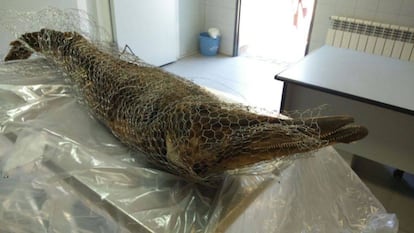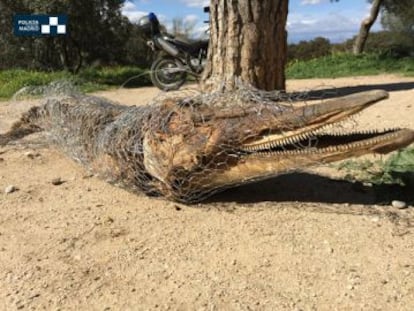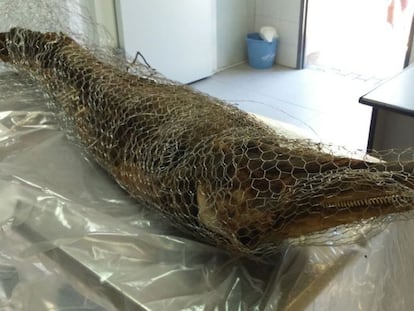Was the Casa de Campo dolphin to be used as a decoration?
Mystery of cetacean corpse found in park in landlocked Madrid still far from being solved
The question remains unanswered: how did a dolphin end up in Madrid’s Casa de Campo park, and who left it there? The extraordinary appearance of the cetacean nearly eight months ago continues to be a mystery. There were no witnesses. But a line of investigation is emerging: the Civil Guard’s Nature Protection Service (Seprona) has ruled out that animal traffickers were involved, as was initially suggested. Instead, there is now another theory: someone found the creature washed up on a beach and brought it to Madrid as a collector’s item. “To conserve its bones or to stuff it,” say investigators.

There is mounting evidence pointing to this second hypothesis. DNA analysis shows that the dolphin found in the Casa de Campo was a Delphinus delphis, or a common ocean dolphin. Study of the animal’s corpse, carried out by scientists at the National Natural Science Museum, ruled out that the specimen was a river dolphin. The difference is significant, given that the latter are more rare and exotic, and as such more likely to be trafficked, says marine biologist Manuel Gosálvez.
The dolphin’s corpse was found on March 30, when César, a dachshund belonging to a nearby resident, found it half buried amid scrubland in the large park on the western edge of the capital. The animal had been wrapped up in chicken wire, which, according to investigators, was new and rust-free, and had therefore most likely been purchased specifically for transporting the dead mammal.
Insects eat the soft tissue and the bones are not lost, as they are in the chicken wire Juan Béjar, president of the National Association of Taxidermists
The wire mesh could also have been used to preserve the animal’s bones. “This is normal when someone wants to keep the skeleton,” explains Juan Béjar, the president of the National Association of Taxidermists. “Insects eat the soft tissue and the bones are not lost, as they are in the chicken wire. This process usually takes five or six months, but there is no demand for dolphin bones in the market.”
Béjar also rules out the possibility that the dolphin’s illegitimate owner wanted to stuff it. From the insects that were in the corpse, investigators were able to determine that the animal had been dead for several months. In fact, it was rotting. “An animal has to be in very good condition if it is to be preserved, it has to be very fresh, because as soon as the skin is slightly gone it can’t be done,” the specialist explains.
His colleague Luis Espetón, a taxidermist who has worked with fish for 20 years, adds another important fact: “Dolphins are a protected species. And we are subject to regulations laid out by Seprona and obliged to follow the law. No colleague would take on such a job. No one has ever asked me to do anything like this, and I never would either.”
The discovery of the dolphin in the Casa de Campo was evidence of a crime
Dolphins are protected under Spanish law. According to the Secretary of State for Commerce, there are regulations covering “the ownership” of such an animal, as well as the “conditions and installations where they are kept” and how their remains are disposed of. As such, the discovery in the Casa de Campo was the evidence of a crime. The public prosecutor opened an investigation into the incident shortly afterwards.
Until now, investigators were working on the assumption that the individual who dumped the dolphin owned a property or land in Madrid big enough to host the animal in a tank or a pool. But in recent weeks, Seprona officers have begun working on the basis that the person they are looking for has a second home outside the Madrid region and may have found the cetacean on a beach.
The search area has since been increased, and with it, the mystery of the Casa de Campo dolphin deepens.
English version by Simon Hunter.
Tu suscripción se está usando en otro dispositivo
¿Quieres añadir otro usuario a tu suscripción?
Si continúas leyendo en este dispositivo, no se podrá leer en el otro.
FlechaTu suscripción se está usando en otro dispositivo y solo puedes acceder a EL PAÍS desde un dispositivo a la vez.
Si quieres compartir tu cuenta, cambia tu suscripción a la modalidad Premium, así podrás añadir otro usuario. Cada uno accederá con su propia cuenta de email, lo que os permitirá personalizar vuestra experiencia en EL PAÍS.
¿Tienes una suscripción de empresa? Accede aquí para contratar más cuentas.
En el caso de no saber quién está usando tu cuenta, te recomendamos cambiar tu contraseña aquí.
Si decides continuar compartiendo tu cuenta, este mensaje se mostrará en tu dispositivo y en el de la otra persona que está usando tu cuenta de forma indefinida, afectando a tu experiencia de lectura. Puedes consultar aquí los términos y condiciones de la suscripción digital.










































